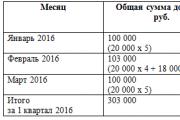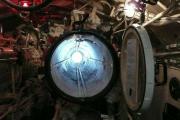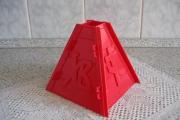The concept of temperature and temperature scale. Temperature definition in physics Temperature is called
Very often in everyday life we use such concepts as heat, hot, cold, characterizing the degree of heating of bodies. This is a subjective approach that depends on our feelings. The degree of heating of bodies can be expressed quantitatively using a physical quantity called temperature. How to accurately determine the temperature? For this purpose, there are devices called thermometers, which are based on the dependence of temperature on some quantity, such as pressure, volume and condition thermal equilibrium.
Thermodynamic equilibrium
Temperature characterizes the state of thermal equilibrium of a system of bodies. If you bring two bodies of different temperatures into contact, the bodies will begin to exchange energy. Bodies with greater kinetic energy will transfer their energy to bodies with less kinetic energy. After some time, this exchange of energy will stop and there will be thermodynamic (thermal) equilibrium, in which bodies can remain for as long as desired. In this state, the temperature of the bodies is the same.
Galileo Galilei, an Italian scientist, expressed the idea of the mechanical nature of heat; in 1597 he built the first thermometer. The thermometer consisted of a glass ball with a tube coming out of it. The tube was lowered into the water, which rose up through it. When the air in the ball was heated or cooled, the column of water either fell or rose up. This thermometer was imperfect, since the height of the water column depended not only on temperature, but also on air pressure.

All other thermometers created later used liquids. But, it was noticed that, unlike liquids, rarefied gases expand and change pressure depending on temperature in the same way. It was experimentally determined for rarefied gases in a state of thermal equilibrium that
Where T – absolute temperature, measured in SI units in Kelvin (K)
k = 1.38*10 -23 J/K – Boltzmann’s constant. Named after the Australian physicist, one of the founders of the MKT theory of gases, Ludwig Boltzmann.
Thanks to this dependence, it became possible to create a temperature scale that does not depend on the type of substance and use it to measure temperature. It was introduced by the English physicist William Thomson, who was named Lord Kelvin in 1892 for his work in the field of physics.
This scale is called absolute (thermodynamic) scale temperatures or Kelvin scale. Beyond the zero point ( absolute zero temperature) on this scale, the point corresponding to the lowest theoretically possible temperature, “the least or last degree of cold,” is accepted. Its existence was predicted by Lomonosov. Temperature T=0 on the Kelvin scale, corresponds to the Celsius scale
In school and university textbooks you can find many different explanations of temperature. Temperature is defined as a value that distinguishes hot from cold, as the degree of heating of a body, as a characteristic of the state of thermal equilibrium, as a value proportional to the energy per degree of freedom of a particle, etc. and so on. Most often, the temperature of a substance is defined as a measure of the average energy of thermal motion of particles of a substance, or as a measure of the intensity of thermal motion of particles. The celestial being of physics, the theorist, will be surprised: “What is incomprehensible here? Temperature is dQ/ dS, Where Q- warmth, and S- entropy! Such an abundance of definitions raises the suspicion among any critically thinking person that a generally accepted scientific definition of temperature does not currently exist in physics.
Let's try to find a simple and specific interpretation of this concept at a level accessible to a high school graduate. Let's imagine this picture. The first snow fell, and two brothers started a fun game known as “snowballs” during recess at school. Let's see what energy is transferred to the players during this competition. For simplicity, we assume that all projectiles hit the target. The game is going on with a clear advantage for the older brother. He also has larger snow balls, and he throws them at greater speed. The energy of all the snowballs thrown by him, where N With– number of throws, and  - average kinetic energy of one ball. The average energy is found using the usual formula:
- average kinetic energy of one ball. The average energy is found using the usual formula:
Here m- mass of snowballs, and v- their speed.
However, not all the energy expended by the older brother will be transferred to his younger partner. In fact, snowballs hit the target at different angles, so some of them, when reflected from a person, carry away part of the original energy. True, there are also “successfully” thrown balls, which can result in a black eye. In the latter case, all the kinetic energy of the projectile is transferred to the subject being fired upon. Thus, we come to the conclusion that the energy of the snowballs transferred to the younger brother will be equal to E With, A  , Where Θ
With– the average value of kinetic energy that is transferred to the younger partner when one snow ball hits him. It is clear that the greater the average energy per thrown ball, the greater the average energy will be Θ
With, transmitted to the target by one projectile. In the simplest case, the relationship between them can be directly proportional: Θ
With =a. Accordingly, the junior student spent energy during the entire competition
, Where Θ
With– the average value of kinetic energy that is transferred to the younger partner when one snow ball hits him. It is clear that the greater the average energy per thrown ball, the greater the average energy will be Θ
With, transmitted to the target by one projectile. In the simplest case, the relationship between them can be directly proportional: Θ
With =a. Accordingly, the junior student spent energy during the entire competition  , but the energy transferred to the older brother will be less: it is equal
, but the energy transferred to the older brother will be less: it is equal  , Where N m– number of throws, and Θ
m– the average energy of one snowball absorbed by its older brother.
, Where N m– number of throws, and Θ
m– the average energy of one snowball absorbed by its older brother.
Something similar happens during the thermal interaction of bodies. If you bring two bodies into contact, the molecules of the first body will transfer energy to the second body in the form of heat in a short period of time.  , Where Δ
S 1
is the number of collisions of molecules of the first body with the second body, and Θ
1
is the average energy that a molecule of the first body transfers to the second body in one collision. During the same time, the molecules of the second body will lose energy
, Where Δ
S 1
is the number of collisions of molecules of the first body with the second body, and Θ
1
is the average energy that a molecule of the first body transfers to the second body in one collision. During the same time, the molecules of the second body will lose energy  . Here Δ
S 2
is the number of elementary acts of interaction (number of impacts) of molecules of the second body with the first body, and Θ
2
- the average energy that a molecule of the second body transfers in one blow to the first body. Magnitude Θ
in physics it is called temperature. As experience shows, it is related to the average kinetic energy of the molecules of bodies by the ratio:
. Here Δ
S 2
is the number of elementary acts of interaction (number of impacts) of molecules of the second body with the first body, and Θ
2
- the average energy that a molecule of the second body transfers in one blow to the first body. Magnitude Θ
in physics it is called temperature. As experience shows, it is related to the average kinetic energy of the molecules of bodies by the ratio:
 (2)
(2)
And now we can summarize all the above arguments. What conclusion should we draw regarding the physical content of the quantity Θ ? It is, in our opinion, completely obvious.
body transfers to another macroscopic object in one
collision with this object.
As follows from formula (2), temperature is an energy parameter, which means that the unit of temperature in the SI system is the joule. So, strictly speaking, you should complain something like this: “It seems like I caught a cold yesterday, my head hurts, and my temperature is as much as 4.294·10 -21 J!” Isn't it an unusual unit for measuring temperature, and the value is somehow too small? But don't forget that we are talking about energy that is a fraction of the average kinetic energy of just one molecule!
In practice, temperature is measured in arbitrarily chosen units: florents, kelvins, degrees Celsius, degrees Rankine, degrees Fahrenheit, etc. (I can determine the length not in meters, but in cables, fathoms, steps, vershoks, feet, etc. I remember that in one of the cartoons the length of a boa constrictor was calculated even in parrots!)
To measure temperature, it is necessary to use some sensor, which should be brought into contact with the object under study. We will call this sensor thermometric body . A thermometric body must have two properties. Firstly, it must be significantly smaller than the object under study (more correctly, the heat capacity of the thermometric body should be much less than the heat capacity of the object under study). Have you ever tried to measure the temperature of, say, a mosquito using a regular medical thermometer? Try it! What, nothing works out? The thing is that during the process of heat exchange, the insect will not be able to change the energy state of the thermometer, since the total energy of the mosquito molecules is negligible compared to the energy of the thermometer molecules.
Well, okay, I’ll take a small object, for example, a pencil, and with its help I’ll try to measure my temperature. Again, something is not going well... And the reason for the failure is that the thermometric body must have one more mandatory property: upon contact with the object under study, changes must occur in the thermometric body that can be recorded visually or using instruments.
Take a closer look at how a regular household thermometer works. Its thermometric body is a small spherical vessel connected to a thin tube (capillary). The vessel is filled with liquid (most often mercury or colored alcohol). Upon contact with a hot or cold object, the liquid changes its volume, and the height of the column in the capillary changes accordingly. But in order to register changes in the height of a liquid column, it is also necessary to attach a scale to the thermometric body. A device containing a thermometric body and a scale chosen in a certain way is called thermometer . The most widely used thermometers at present are the Celsius scale and the Kelvin scale.
The Celsius scale is established by two reference (reference) points. The first reference point is the triple point of water - those physical conditions under which the three phases of water (liquid, gas, solid) are in equilibrium. This means that the mass of liquid, the mass of water crystals and the mass of water vapor remain unchanged under these conditions. In such a system, of course, the processes of evaporation and condensation, crystallization and melting occur, but they balance each other. If very high accuracy of temperature measurement is not needed (for example, in the manufacture of household thermometers), the first reference point is obtained by placing the thermometric body in snow or ice that melts at atmospheric pressure. The second reference point is the conditions under which liquid water is in equilibrium with its vapor (in other words, the boiling point of water) at normal atmospheric pressure. Marks are made on the thermometer scale corresponding to reference points; the interval between them is divided into one hundred parts. One division of the scale chosen in this way is called a degree Celsius (˚C). The triple point of water is taken to be 0 degrees Celsius.
The Celsius scale has received the greatest practical use in the world; unfortunately, it has a number of significant drawbacks. Temperature on this scale can take negative values, while kinetic energy and, accordingly, temperature can only be positive. In addition, the readings of thermometers with the Celsius scale (with the exception of reference points) depend on the choice of thermometric body.
The Kelvin scale does not have the disadvantages of the Celsius scale. An ideal gas must be used as a working substance in thermometers with the Kelvin scale. The Kelvin scale is also established by two reference points. The first reference point is the physical conditions under which the thermal motion of ideal gas molecules stops. This point is taken as 0 on the Kelvin scale. The second reference point is the triple point of water. The interval between reference points is divided into 273.15 parts. One division of the scale chosen in this way is called kelvin (K). The number of divisions 273.15 was chosen so that the division price of the Kelvin scale coincides with the division price of the Celsius scale, then the change in temperature on the Kelvin scale coincides with the change in temperature on the Celsius scale; This makes it easier to move from reading one scale to another. Temperature on the Kelvin scale is usually indicated by the letter T. Relationship between temperatures t in Celsius scale and temperature T, measured in kelvins, is established by the relations
 And
And  .
.
To change from temperature T, measured in K, to temperature Θ Boltzmann's constant is used in joules k=1.38·10 -23 J/K, it shows how many joules per 1 K:
Θ = kT.
Some clever people try to find some secret meaning in the Boltzmann constant; meanwhile k- the most ordinary coefficient for converting temperature from Kelvin to Joules.
Let us draw the reader's attention to three specific features of temperature. Firstly, it is an averaged (statistical) parameter of an ensemble of particles. Imagine that you decided to find the average age of people on Earth. To do this, we go to the kindergarten, sum up the ages of all the children and divide this amount by the number of children. It turns out that the average age of people on Earth is 3.5 years! It seemed like they thought it right, but the result they got was ridiculous. But the whole point is that in statistics you need to operate with a huge number of objects or events. The higher their number (ideally it should be infinitely large), the more accurate the value of the average statistical parameter will be. Therefore, the concept of temperature is applicable only to bodies containing a huge number of particles. When a journalist, in pursuit of a sensation, reports that the temperature of particles falling on a spaceship is several million degrees, the relatives of the astronauts do not have to faint: nothing terrible happens to the ship: just an illiterate writer passes off the energy of a small number of cosmic particles as temperature. But if the ship, heading to Mars, were to lose its course and approach the Sun, then there would be trouble: the number of particles bombarding the ship is enormous, and the temperature of the solar corona is 1.5 million degrees.
Secondly, temperature characterizes thermal, i.e. disordered movement of particles. In an electronic oscilloscope, the picture on the screen is drawn by a narrow stream of electrons, focused to a point. These electrons pass through a certain identical potential difference and acquire approximately the same speed. For such an ensemble of particles, a competent specialist indicates their kinetic energy (for example, 1500 electron volts), which, of course, is not the temperature of these particles.
Finally, thirdly, we note that the transfer of heat from one body to another can be carried out not only due to the direct collision of particles of these bodies, but also due to the absorption of energy in the form of quanta of electromagnetic radiation (this process occurs when you sunbathe on the beach) . Therefore, a more general and accurate definition of temperature should be formulated as follows:
The temperature of a body (substance, system) is a physical quantity that is numerically equal to the average energy that a molecule of this
body transfers to another macroscopic object in one
the elementary act of interaction with this object.
In conclusion, let's return to the definitions discussed at the beginning of this article. From formula (2) it follows that if the temperature of the substance is known, then the average energy of the particles of the substance can be unambiguously determined. Thus, temperature is really a measure of the average energy of thermal motion of molecules or atoms (note, by the way, that the average energy of particles cannot be determined directly in experiment). On the other hand, kinetic energy is proportional to the square of the speed; This means that the higher the temperature, the higher the speed of the molecules, the more intense their movement. Therefore, temperature is a measure of the intensity of thermal motion of particles. These definitions are certainly acceptable, but they are too general and purely qualitative in nature.
Temperature is easy!
Temperature
Temperature is a measure of the average kinetic energy of molecules.
Temperature characterizes the degree of heating of bodies.
Temperature measuring device - thermometer.
Operating principle thermometer:
When measuring temperature, the dependence of the change in any macroscopic parameter (volume, pressure, electrical resistance, etc.) of a substance on temperature is used.
In liquid thermometers, this is a change in the volume of liquid.
When two media come into contact, energy is transferred from the more heated environment to the less heated one.
During the measurement process, the body temperature and the thermometer reach a state of thermal equilibrium.
Liquid thermometers
In practice, liquid thermometers are often used: mercury (in the range from -35 o C to +750 o C) and alcohol (from -80 o C to +70 o C).
They use the property of a liquid to change its volume when the temperature changes.
However, each liquid has its own characteristics of volume change (expansion) at different temperatures.
As a result of comparing, for example, the readings of mercury and alcohol thermometers, an exact match will be only at two points (at temperatures of 0 o C and 100 o C).
Gas thermometers do not have these disadvantages.
Gas thermometers
The first gas thermometer was created by the French physicist J. Charles.
Advantages gas thermometer:
- a linear dependence of the change in gas volume or pressure on temperature is used, which is valid for all gases
- measurement accuracy from 0.003 o C to 0.02 o C
- temperature range from -271 o C to +1027 o C.
Thermal equilibrium
When two bodies of different temperatures come into contact, internal energy is transferred from the more heated body to the less heated one, and the temperatures of both bodies are equalized.
A state of thermal equilibrium occurs, in which all macroparameters (volume, pressure, temperature) of both bodies subsequently remain unchanged under constant external conditions.
Thermal equilibrium is a state in which all macroscopic parameters remain unchanged for an indefinitely long time.
The state of thermal equilibrium of a system of bodies is characterized by temperature: all bodies of the system that are in thermal equilibrium with each other have the same temperature.
It has been established that at thermal equilibrium, the average kinetic energies of the translational motion of the molecules of all gases are the same, i.e.

For rarefied (ideal) gases the value
and depends only on temperature, then
where k is Boltzmann's constant
This dependence makes it possible to introduce a new temperature scale - an absolute temperature scale that does not depend on the substance used to measure temperature.
Absolute temperature scale
Introduced by the English physicist W. Kelvin
- no negative temperatures
SI unit of absolute temperature: [T] = 1K (Kelvin)
The zero temperature of the absolute scale is absolute zero (0K = -273 o C), the lowest temperature in nature. Currently, the lowest temperature has been reached - 0.0001K.
The value of 1K is equal to 1 o C.

Relationship between the absolute scale and the Celsius scale
Remember! In formulas, absolute temperature is denoted by the letter “T”, and temperature on the Celsius scale by the letter “t”.
After introducing the absolute temperature we get new expressions for formulas:
Average kinetic energy of translational motion of molecules

Gas pressure - the basic equation of MKT
Mean square speed of molecules
Plan:
- Introduction
- 1
Thermodynamic definition
- 1.1 History of the thermodynamic approach
- 2 Determination of temperature in statistical physics
- 3 Temperature measurement
- 4
Temperature units and scale
- 4.1 Kelvin temperature scale
- 4.2 Celsius scale
- 4.3 Fahrenheit
- 5
Energy of thermal motion at absolute zero
- 5.1 Temperature and radiation
- 5.2 Reaumur scale
- 6 Transitions from different scales
- 7 Comparison of temperature scales
- 8 Characteristics of phase transitions
- 9 Interesting Facts Notes
Literature
Introduction
Temperature(from lat. temperatura- proper mixing, normal state) is a scalar physical quantity that characterizes the average kinetic energy of particles of a macroscopic system in a state of thermodynamic equilibrium per one degree of freedom.
The measure of temperature is not the movement itself, but the chaotic nature of this movement. The randomness of the state of a body determines its temperature state, and this idea (which was first developed by Boltzmann) that a certain temperature state of a body is not at all determined by the energy of movement, but by the randomness of this movement, is the new concept in the description of temperature phenomena that we must use. ..
(P. L. Kapitsa)
In the International System of Units (SI), thermodynamic temperature is one of the seven basic units and is expressed in kelvins. The derived SI quantities, which have a special name, include Celsius temperature, measured in degrees Celsius. In practice, degrees Celsius are often used due to their historical connection to important characteristics of water - the melting point of ice (0 °C) and the boiling point (100 °C). This is convenient since most climate processes, processes in wildlife, etc. are associated with this range. A change in temperature of one degree Celsius is equivalent to a change in temperature of one Kelvin. Therefore, after the introduction of a new definition of Kelvin in 1967, the boiling point of water ceased to play the role of a constant reference point and, as accurate measurements show, it is no longer equal to 100 °C, but close to 99.975 °C.
There are also Fahrenheit scales and some others.
1. Thermodynamic definition
The existence of an equilibrium state is called the first initial position of thermodynamics. The second initial position of thermodynamics is the statement that the equilibrium state is characterized by a certain quantity, which, upon thermal contact of two equilibrium systems, becomes the same for them as a result of the exchange of energy. This quantity is called temperature.
1.1. History of the thermodynamic approach
The word “temperature” arose in those days when people believed that more heated bodies contained a larger amount of a special substance - caloric - than less heated ones. Therefore, temperature was perceived as the strength of a mixture of body matter and caloric. For this reason, the units of measurement for the strength of alcoholic beverages and temperature are called the same - degrees.
In an equilibrium state, the temperature has the same value for all macroscopic parts of the system. If two bodies in a system have the same temperature, then there is no transfer of kinetic energy of particles (heat) between them. If there is a temperature difference, then heat moves from a body with a higher temperature to a body with a lower one, because the total entropy increases.
Temperature is also associated with the subjective sensations of “warm” and “cold”, related to whether living tissue gives off or receives heat.
Some quantum mechanical systems may be in a state in which entropy does not increase but decreases with the addition of energy, which formally corresponds to a negative absolute temperature. However, such states are not “below absolute zero”, but “above infinity”, since when such a system comes into contact with a body with a positive temperature, energy is transferred from the system to the body, and not vice versa (for more details, see Quantum thermodynamics).
The properties of temperature are studied by the branch of physics - thermodynamics. Temperature also plays an important role in many areas of science, including other branches of physics, as well as chemistry and biology.
2. Determination of temperature in statistical physics
In statistical physics, temperature is determined by the formula
,where S is entropy, E is the energy of the thermodynamic system. The value T introduced in this way is the same for different bodies at thermodynamic equilibrium. When two bodies come into contact, the body with a large T value will transfer energy to the other.
3. Temperature measurement
To measure thermodynamic temperature, a certain thermodynamic parameter of the thermometric substance is selected. A change in this parameter is clearly associated with a change in temperature. A classic example of a thermodynamic thermometer is a gas thermometer, in which the temperature is determined by measuring the gas pressure in a cylinder of constant volume. Absolute radiation, noise, and acoustic thermometers are also known.
Thermodynamic thermometers are very complex units that cannot be used for practical purposes. Therefore, most measurements are made using practical thermometers, which are secondary, since they cannot directly relate any property of a substance to temperature. To obtain the interpolation function, they must be calibrated at reference points on the international temperature scale. The most accurate practical thermometer is the platinum resistance thermometer. Temperature measuring instruments are often calibrated on relative scales - Celsius or Fahrenheit.
In practice, temperature is also measured
- liquid and mechanical thermometers,
- thermocouple,
- resistance thermometer,
- gas thermometer,
- pyrometer.
The latest methods for measuring temperature have been developed, based on measuring the parameters of laser radiation.
4. Units and scale of temperature measurement
Since temperature is the kinetic energy of molecules, it is clear that it is most natural to measure it in energy units (that is, in the SI system in joules). However, temperature measurement began long before the creation of the molecular kinetic theory, so practical scales measure temperature in conventional units - degrees.
4.1. Kelvin temperature scale
The concept of absolute temperature was introduced by W. Thomson (Kelvin), and therefore the absolute temperature scale is called the Kelvin scale or thermodynamic temperature scale. The unit of absolute temperature is kelvin (K).
The absolute temperature scale is so called because the measure of the ground state of the lower limit of temperature is absolute zero, that is, the lowest possible temperature at which, in principle, it is impossible to extract thermal energy from a substance.
Absolute zero is defined as 0 K, which is equal to −273.15 °C (exactly).
The Kelvin temperature scale is a scale that starts at absolute zero.
Of great importance is the development, based on the Kelvin thermodynamic scale, of International practical scales based on reference points - phase transitions of pure substances determined by primary thermometry methods. The first international temperature scale was adopted in 1927 by ITS-27. Since 1927, the scale has been redefined several times (MTSh-48, MPTS-68, MTSh-90): reference temperatures and interpolation methods have changed, but the principle remains the same - the basis of the scale is a set of phase transitions of pure substances with certain values of thermodynamic temperatures and interpolation instruments calibrated at these points. The ITS-90 scale is currently in effect. The main document (Regulations on the scale) establishes the definition of Kelvin, the values of phase transition temperatures (reference points) and interpolation methods.
Temperature scales used in everyday life - both Celsius and Fahrenheit (used mainly in the USA) - are not absolute and therefore inconvenient when conducting experiments in conditions where the temperature drops below the freezing point of water, which is why the temperature must be expressed negative number. For such cases, absolute temperature scales were introduced.
One of them is called the Rankine scale, and the other is the absolute thermodynamic scale (Kelvin scale); their temperatures are measured in degrees Rankine (°Ra) and kelvins (K), respectively. Both scales begin at absolute zero temperature. They differ in that the price of one division on the Kelvin scale is equal to the price of a division on the Celsius scale, and the price of one division on the Rankine scale is equivalent to the price of division of thermometers with the Fahrenheit scale. The freezing point of water at standard atmospheric pressure corresponds to 273.15 K, 0 °C, 32 °F.
The Kelvin scale is tied to the triple point of water (273.16 K), and the Boltzmann constant depends on it. This creates problems with the accuracy of interpretation of high temperature measurements. The BIPM is now considering the possibility of moving to a new definition of Kelvin and fixing the Boltzmann constant, instead of reference to the triple point temperature. .
4.2. Celsius
In technology, medicine, meteorology and in everyday life, the Celsius scale is used, in which the temperature of the triple point of water is 0.008 °C, and, therefore, the freezing point of water at a pressure of 1 atm is 0 °C. Currently, the Celsius scale is determined through the Kelvin scale: the price of one division on the Celsius scale is equal to the price of a division on the Kelvin scale, t(°C) = T(K) - 273.15. Thus, the boiling point of water, originally chosen by Celsius as a reference point of 100 °C, has lost its significance, and modern estimates put the boiling point of water at normal atmospheric pressure at about 99.975 °C. The Celsius scale is practically very convenient, since water is very widespread on our planet and our life is based on it. Zero Celsius is a special point for meteorology because it is associated with the freezing of atmospheric water. The scale was proposed by Anders Celsius in 1742.
4.3. Fahrenheit
In England and especially in the USA, the Fahrenheit scale is used. Zero degrees Celsius is 32 degrees Fahrenheit, and a degree Fahrenheit is 9/5 degrees Celsius.
The current definition of the Fahrenheit scale is as follows: it is a temperature scale in which 1 degree (1 °F) is equal to 1/180th the difference between the boiling point of water and the melting temperature of ice at atmospheric pressure, and the melting point of ice is +32 °F. Temperature on the Fahrenheit scale is related to temperature on the Celsius scale (t °C) by the ratio t °C = 5/9 (t °F - 32), t °F = 9/5 t °C + 32. Proposed by G. Fahrenheit in 1724 .
5. Energy of thermal motion at absolute zero
When matter cools, many forms of thermal energy and their associated effects simultaneously decrease in magnitude. Matter moves from a less ordered state to a more ordered one.
... the modern concept of absolute zero is not the concept of absolute rest; on the contrary, at absolute zero there can be movement - and it exists, but it is a state of complete order ...
P. L. Kapitsa (Properties of liquid helium)
The gas turns into a liquid and then crystallizes into a solid (helium, even at absolute zero, remains in a liquid state at atmospheric pressure). The movement of atoms and molecules slows down, their kinetic energy decreases. The resistance of most metals decreases due to a decrease in electron scattering on atoms of the crystal lattice vibrating with a lower amplitude. Thus, even at absolute zero, conduction electrons move between atoms with a Fermi speed of the order of 1 × 10 6 m/s.
The temperature at which particles of matter have a minimum amount of motion, preserved only due to quantum mechanical motion, is the temperature of absolute zero (T = 0K).
Absolute zero temperature cannot be reached. The lowest temperature (450 ± 80) × 10 −12 K of the Bose-Einstein condensate of sodium atoms was obtained in 2003 by researchers from MIT. In this case, the peak of thermal radiation is located in the wavelength region of the order of 6400 km, that is, approximately the radius of the Earth.
5.1. Temperature and radiation
The energy emitted by a body is proportional to the fourth power of its temperature. So, at 300 K, up to 450 watts are emitted from a square meter of surface. This explains, for example, the cooling of the earth's surface at night below the ambient temperature. The radiation energy of an absolutely black body is described by the Stefan-Boltzmann law
5.2. Reaumur scale
Proposed in 1730 by R. A. Reaumur, who described the alcohol thermometer he invented.
The unit is the degree Reaumur (°R), 1 °R is equal to 1/80 of the temperature interval between the reference points - the melting temperature of ice (0 °R) and the boiling point of water (80 °R)
1 °R = 1.25 °C.
Currently, the scale has fallen out of use; it survived longest in France, the author’s homeland.
6. Transitions from different scales
7. Comparison of temperature scales
| Description | Kelvin | Celsius | Fahrenheit | Rankin | Delisle | Newton | Reaumur | Roemer |
|---|---|---|---|---|---|---|---|---|
| Absolute zero | 0 | −273.15 | −459.67 | 0 | 559.725 | −90.14 | −218.52 | −135.90 |
| Melting temperature of Fahrenheit mixture (salt and ice in equal quantities) | 255.37 | −17.78 | 0 | 459.67 | 176.67 | −5.87 | −14.22 | −1.83 |
| Freezing point of water (Normal conditions) | 273.15 | 0 | 32 | 491.67 | 150 | 0 | 0 | 7.5 |
| Average human body temperature¹ | 310.0 | 36.6 | 98.2 | 557.9 | 94.5 | 12.21 | 29.6 | 26.925 |
| Boiling point of water (Normal conditions) | 373.15 | 100 | 212 | 671.67 | 0 | 33 | 80 | 60 |
| Melting titanium | 1941 | 1668 | 3034 | 3494 | −2352 | 550 | 1334 | 883 |
| Surface of the Sun | 5800 | 5526 | 9980 | 10440 | −8140 | 1823 | 4421 | 2909 |
¹ The normal average human body temperature is 36.6 °C ±0.7 °C, or 98.2 °F ±1.3 °F. The commonly quoted value of 98.6 °F is an exact conversion to Fahrenheit of the 19th century German value of 37 °C. However, this value is not within the range of normal average human body temperature, since the temperature of different parts of the body is different.
Some values in this table have been rounded.
8. Characteristics of phase transitions
To describe the phase transition points of various substances, the following temperature values are used:
- Melting temperature
- Boiling temperature
- Annealing temperature
- Sintering temperature
- Synthesis temperature
- Air temperature
- Soil temperature
- Homologous temperature
- Triple point
- Debye temperature (Characteristic temperature)
- Curie temperature
9. Interesting facts
The lowest temperature on Earth until 1910 −68, Verkhoyansk
- Highest temperature created by man, ~10 trillion. K (which is comparable to the temperature of the Universe in the first seconds of its life) was reached in 2010 during the collision of lead ions accelerated to near-light speeds. The experiment was carried out at the Large Hadron Collider
- The highest theoretically possible temperature is the Planck temperature. A higher temperature cannot exist since everything turns into energy (all subatomic particles will collapse). This temperature is approximately 1.41679(11)×10 32 K (approximately 142 nonillion K).
- The lowest temperature created by man was obtained in 1995 by Eric Cornell and Carl Wieman from the USA by cooling rubidium atoms. . It was above absolute zero by less than 1/170 billionth of a fraction of a K (5.9 × 10 −12 K).
- The surface of the Sun has temperatures of about 6000 K.
- Seeds of higher plants remain viable after cooling to −269 °C.
Notes
- GOST 8.417-2002. UNITS OF QUANTITIES - nolik.ru/systems/gost.htm
- The concept of temperature - temperatures.ru/mtsh/mtsh.php?page=1
- I. P. Bazarov. Thermodynamics, M., Higher School, 1976, p. 13-14.
- Platinum - temperatures.ru/mtsh/mtsh.php?page=81 resistance thermometer - the main device MTSH-90.
- Laser thermometry - temperatures.ru/newmet/newmet.php?page=0
- MTSH-90 reference points - temperatures.ru/mtsh/mtsh.php?page=3
- Development of a new definition of Kelvin - temperatures.ru/kelvin/kelvin.php?page=2
- D. A. Parshin, G. G. Zegrya Critical point. Properties of a substance in a critical state. Triple point. Phase transitions of the second order. Methods for obtaining low temperatures. - edu.ioffe.spb.ru/edu/thermodinamics/lect11h.pdf. Statistical thermodynamics. Lecture 11. St. Petersburg Academic University.
- About various body temperature measurements - hypertextbook.com/facts/LenaWong.shtml (English)
- BBC News - Large Hadron Collider (LHC) generates a "mini-Big Bang" - www.bbc.co.uk/news/science-environment-11711228
- Everything about everything. Temperature records - tem-6.narod.ru/weather_record.html
- Wonders of science - www.seti.ee/ff/34gin.swf
Literature
- B. I. Spassky History of physics Part I - osnovanija.narod.ru/History/Spas/T1_1.djvu. - Moscow: “Higher School”, 1977.
- Sivukhin D.V. Thermodynamics and molecular physics. - Moscow: “Science”, 1990.
This abstract is based on an article from Russian Wikipedia. Synchronization completed 07/09/11 16:20:43
Similar abstracts:














